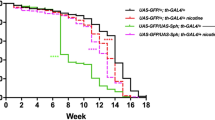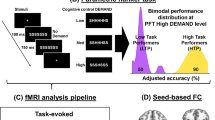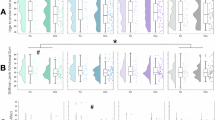Abstract
Tobacco addiction is a global public health problem. Addiction to tobacco is thought to involve the effects of nicotine on the dopaminergic system. Only one study has previously investigated dopamine synthesis capacity in cigarette smokers. This study, exclusively in male volunteers, reported increased dopamine synthesis capacity in heavy smokers compared with non-smokers. We sought to determine whether dopamine synthesis capacity was elevated in a larger sample of cigarette smokers that included females. Dopamine synthesis capacity was measured in 15 daily moderate smokers with 15 sex- and age-matched control subjects who had never smoked tobacco. Dopamine synthesis capacity (indexed as the influx rate constant Kicer) was measured with positron emission tomography and 3,4-dihydroxy-6-[18F]-fluoro-l-phenylalanine. There was no significant group difference in dopamine synthesis capacity between smokers and non-smoker controls in the whole striatum (t28=0.64, p=0.53) or any of its functional subdivisions. In smokers, there were no significant relationships between the number of cigarettes smoked per day and dopamine synthesis capacity in the whole striatum (r=−0.23, p=0.41) or any striatal subdivision. These findings indicate that moderate smoking is not associated with altered striatal dopamine synthesis capacity.
Similar content being viewed by others
Log in or create a free account to read this content
Gain free access to this article, as well as selected content from this journal and more on nature.com
or
References
Balfour DJ, Wright AE, Benwell ME, Birrell CE (2000). The putative role of extra-synaptic mesolimbic dopamine in the neurobiology of nicotine dependence. Behav Brain Res 113: 73–83.
Barkus EJ, Stirling J, Hopkins RS, Lewis S (2006). Cannabis-induced psychosis-like experiences are associated with high schizotypy. Psychopathology 39: 175–178.
Barrett SP, Boileau I, Okker J, Pihl RO, Dagher A (2004). The hedonic response to cigarette smoking is proportional to dopamine release in the human striatum as measured by positron emission tomography and [11C]raclopride. Synapse 54: 65–71.
Benowitz NL, Henningfield JE (1994). Establishing a nicotine threshold for addiction. The implications for tobacco regulation. N Engl J Med 331: 123–125.
Benowitz NL, Jacob P 3rd, Jones RT, Rosenberg J (1982). Interindividual variability in the metabolism and cardiovascular effects of nicotine in man. J Pharmacol Exp Ther 221: 368–372.
Bloomfield MA, Morgan CJ, Egerton A, Kapur S, Curran HV, Howes OD (2013). Dopaminergic Function in Cannabis Users and Its Relationship to Cannabis-Induced Psychotic Symptoms. Biol Psychiatry 75: 470–478.
Bock KW, Köhle C (2004). Coordinate regulation of drug metabolism by xenobiotic nuclear receptors: UGTs acting together with CYPs and glucuronide transporters. Drug Metab Rev 36: 595–615.
Boyes BE, Cumming P, Martin WR, McGeer EG (1986). Determination of plasma [18F]-6-fluorodopa during positron emission tomography: elimination and metabolism in carbidopa treated subjects. Life Sci 39: 2243–2252.
Brody AL, Olmstead RE, London ED, Farahi J, Meyer JH, Grossman P et al (2004). Smoking-induced ventral striatum dopamine release. Am J Psychiatry 161: 1211–1218.
Busto UE, Redden L, Mayberg H, Kapur S, Houle S, Zawertailo LA (2009). Dopaminergic activity in depressed smokers: a positron emission tomography study. Synapse 63: 681–689.
Chiuccariello L, Guranda M, Rusjan PM, Wilson AA, Zawertailo L, Houle S et al (2013). Presentation of smoking-associated cues does not elicit dopamine release after one-hour smoking abstinence: A [11C]-(+)-PHNO PET study. PLoS One 8: e60382.
Clarke PB, Pert A (1985). Autoradiographic evidence for nicotine receptors on nigrostriatal and mesolimbic dopaminergic neurons. Brain Res 348: 355–358.
Connolly GN, Alpert HR, Wayne GF, Koh H (2007). Trends in nicotine yield in smoke and its relationship with design characteristics among popular US cigarette brands, 1997-2005. Tob Control 16: e5.
Cumming P, Leger GC, Kuwabara H, Gjedde A (1993). Pharmacokinetics of plasma 6-[18F]fluoro-L-3,4-dihydroxyphenylalanine ([18F]Fdopa) in humans. J Cereb Blood Flow Metab 13: 668–675.
Cumming P, Boyes BE, Martin WR, Adam M, Grierson J, Ruth T et al (1987). The metabolism of [18F]6-fluoro-L-3,4-dihydroxyphenylalanine in the hooded rat. J Neurochem 48: 601–608.
Dewey SL, Brodie JD, Gerasimov M, Horan B, Gardner EL, Ashby CR Jr (1999). A pharmacologic strategy for the treatment of nicotine addiction. Synapse 31: 76–86.
Dierker LC, Avenevoli S, Stolar M, Merikangas KR (2002). Smoking and depression: an examination of mechanisms of comorbidity. Am J Psychiatry 159: 947–953.
Dluzen DE, Anderson LI (1997). Estrogen differentially modulates nicotine-evoked dopamine release from the striatum of male and female rats. Neurosci Lett 230: 140–142.
Egerton A, Demjaha A, McGuire P, Mehta MA, Howes OD (2010). The test-retest reliability of 18F-DOPA PET in assessing striatal and extrastriatal presynaptic dopaminergic function. Neuroimage 50: 524–531.
Ezzati M, Lopez AD (2003). Estimates of global mortality attributable to smoking in 2000. Lancet 362: 847–852.
First MB SR, Gibbon M, Williams JBW (1996) Structured Clinical Interview for DSM-IV Axis I Disorders, Clinician Version (SCID-CV).. American Psychiatric Press: Washington, DC.
Fowler JS, Volkow ND, Wang GJ, Pappas N, Logan J, MacGregor R et al (1996a). Inhibition of monoamine oxidase B in the brains of smokers. Nature 379: 733–736.
Fowler JS, Volkow ND, Wang GJ, Pappas N, Logan J, Shea C et al (1996b). Brain monoamine oxidase A inhibition in cigarette smokers. Proc Natl Acad Sci USA 93: 14065–14069.
Gallezot JD, Kloczynski T, Weinzimmer D, Labaree D, Zheng MQ, Lim K et al (2013). Imaging nicotine- and amphetamine-induced dopamine release in Rhesus monkeys with [11C]PHNO vs [11C]raclopride PET. Neuropsychopharmacology 39: 866–874.
Geracioti TD Jr, West SA, Baker DG, Hill KK, Ekhator NN, Wortman MD et al (1999). Low CSF concentration of a dopamine metabolite in tobacco smokers. Am J Psychiatry 156: 130–132.
Guttman M, Leger G, Reches A, Evans A, Kuwabara H, Cedarbaum JM et al (1993). Administration of the new COMT inhibitor OR-611 increases striatal uptake of fluorodopa. Mov Disord 8: 298–304.
Grenhoff J, Aston-Jones G, Svensson TH (1986). Nicotinic effects on the firing pattern of midbrain dopamine neurons. Acta Physiol Scand 128: 351–358.
Haber SN (2003). The primate basal ganglia: parallel and integrative networks. J Chem Neuroanat 26: 317–330.
Heinz A, Siessmeier T, Wrase J, Buchholz HG, Gründer G, Kumakura Y et al (2005). Correlation of alcohol craving with striatal dopamine synthesis capacity and D2/3 receptor availability: a combined [18F]DOPA and [18F]DMFP PET study in detoxified alcoholic patients. Am J Psychiatry 162: 1515–1520.
Hietala J, Syvälahti E, Vilkman H, Vuorio K, Räkköläinen V, Bergman J et al (1999). Depressive symptoms and presynaptic dopamine function in neuroleptic-naive schizophrenia. Schizophr Res. 35: 41–50.
Howes OD, Montgomery AJ, Asselin MC, Murray RM, Valli I, Tabraham P et al (2009). Elevated striatal dopamine function linked to prodromal signs of schizophrenia. Arch Gen Psychiatry 66: 13–20.
Hughes JR, Keely J, Naud S (2004). Shape of the relapse curve and long-term abstinence among untreated smokers. Addiction 99: 29–38.
Kendler KS, Neale MC, MacLean CJ, Heath AC, Eaves LJ, Kessler RC (1993). Smoking and major depression. A causal analysis. Arch Gen Psychiatry 50: 36–43.
Koob GF (1992). Neural mechanisms of drug reinforcement. Ann N Y Acad Sci 654: 171–191.
Kumakura Y, Cumming P (2009). PET studies of cerebral levodopa metabolism: a review of clinical findings and modeling approaches. Neuroscientist 15: 635–650.
Laakso A, Vilkman H, Bergman J, Haaparanta M, Solin O, Syvälahti E et al (2002). Sex differences in striatal presynaptic dopamine synthesis capacity in healthy subjects. Biol Psychiatry 52: 753–763.
Lautala P, Ethell BT, Taskinen J, Burchell B (2000). The specificity of glucuronidation of entacapone and tolcapone by recombinant human UDP-glucuronosyltransferases. Drug Metab Dispos 28: 1385–1389.
Le Foll B, Guranda M, Wilson AA, Houle S, Rusjan PM, Wing VC et al (2013). Elevation of Dopamine Induced by Cigarette Smoking: Novel Insights from a [11C]-(+)-PHNO PET Study in Humans. Neuropsychopharmacology 39: 415–424.
Lerman C, Caporaso N, Main D, Audrain J, Boyd NR, Bowman ED et al (1998). Depression and self-medication with nicotine: the modifying influence of the dopamine D4 receptor gene. Health Psychol 17: 56–62.
Marenco S, Carson RE, Berman KF, Herscovitch P, Weinberger DR (2004). Nicotine-induced dopamine release in primates measured with [11C]raclopride PET. Neuropsychopharmacology 29: 257–268.
Martinez D, Slifstein M, Broft A, Mawlawi T, Hwang DR, Huang YY et al (2003). Imaging human mesolimbic dopamine transmission with positron emission tomography. Part II: amphetamine-induced dopamine release in the functional subdivisions of the striatum. J Cerebr Blood F Met 23: 285–300.
Menossi HS, Goudriaan AE, de Azevedo-Marques Périco C, Nicastri S, de Andrade AG, D’Elia G et al (2013). Neural bases of pharmacological treatment of nicotine dependence—insights from functional brain imaging: a systematic review. CNS Drugs 27: 921–941.
Montgomery AJ, Lingford-Hughes AR, Egerton A, Nutt DJ, Grasby PM (2007). The effect of nicotine on striatal dopamine release in man: A [11C]raclopride PET study. Synapse 61: 637–645.
Office for National Statistics (2013) Opinions and Lifestyle Survey, Smoking Habits Amongst Adults, 2012. Office for National Statistics: London, United Kingdom.
Pidoplichko VI, DeBiasi M, Williams JT, Dani JA (1997). Nicotine activates and desensitizes midbrain dopamine neurons. Nature 390: 401–404.
Pontieri FE, Tanda G, Orzi F, Di Chiara G (1996). Effects of nicotine on the nucleus accumbens and similarity to those of addictive drugs. Nature 382: 255–257.
Salokangas RK, Vilkman H, Ilonen T, Taiminen T, Bergman J, Haaparanta M et al (2000). High levels of dopamine activity in the basal ganglia of cigarette smokers. Am J Psychiatry 157: 632–634.
Sossi V, Holden JE, de la Fuente-Fernandez R, Ruth TJ, Stoessl AJ. (2003). Effect of dopamine loss and the metabolite 3-O-methyl-[18F]fluoro-dopa on the relation between the 18F-fluorodopa tissue input uptake rate constant K occ and the [18F]fluorodopa plasma input uptake rate constant Ki. J Cereb Blood Flow Metab. 23: 301–309.
Stolerman IP, Mirza NR, Shoaib M (1995). Nicotine psychopharmacology: addiction, cognition and neuroadaptation. Med Res Rev 15: 47–72.
Studholme C, Hill DL, Hawkes DJ (1996). Automated 3-D registration of MR and CT images of the head. Med Image Anal 1: 163–175.
Tai YF, Hoshi R, Brignell CM, Cohen L, Brooks DJ, Curran HV et al (2011). Persistent nigrostriatal dopaminergic abnormalities in ex-users of MDMA (‘Ecstasy’): an 18F-dopa PET study. Neuropsychopharmacology 36: 735–743.
Thomsen G, Knudsen GM, Jensen PS, Ziebell M, Holst KK, Asenbaum S et al (2013). No difference in striatal dopamine transporter availability between active smokers, ex-smokers and non-smokers using [123I]FP-CIT (DaTSCAN) and SPECT. EJNMMI Res 3: 39.
Tsukada H, Miyasato K, Harada N, Nishiyama S, Fukumoto D, Kakiuchi T (2005). Nicotine modulates dopamine synthesis rate as determined by L-[beta-11C]DOPA: PET studies compared with [11C]raclopride binding in the conscious monkey brain. Synapse 57: 120–122.
Turkheimer FE, Brett M, Visvikis D, Cunningham VJ (1999). Multiresolution analysis of emission tomography images in the wavelet domain. J Cereb Blood Flow Metab 19: 1189–1208.
Villard PH, Herber R, Sérée EM, Attolini L, Magdalou J, Lacarelle B (1998). Effect of cigarette smoke on UDP-glucuronosyltransferase activity and cytochrome P450 content in liver, lung and kidney microsomes in mice. Pharmacol Toxicol 82: 74–79.
Volkow ND, Wang GJ, Fowler JS, Tomasi D, Telang F (2011). Addiction: beyond dopamine reward circuitry. Proc Natl Acad Sci USA 108: 15037–15042.
Wang GJ, Smith L, Volkow ND, Telang F, Logan J, Tomasi D et al (2012). Decreased dopamine activity predicts relapse in methamphetamine abusers. Mol Psychiatry 17: 918–925.
West R, McNeill A, Raw M (2000). Smoking cessation guidelines for health professionals: an update. Health Education Authority. Thorax 55: 987–999.
Wu JC, Bell K, Najafi A, Widmark C, Keator D, Tang C et al (1997). Decreasing striatal 6-FDOPA uptake with increasing duration of cocaine withdrawal. Neuropsychopharmacology 17: 402–409.
Zhang H, Sulzer D (2004). Frequency-dependent modulation of dopamine release by nicotine. Nat Neurosci 7: 581–582.
Zhang L, Kendler KS, Chen X (2006). The mu-opioid receptor gene and smoking initiation and nicotine dependence. Behav Brain Funct 2: 28.
Acknowledgements
We thank our subjects and the staff of GE Imanet for their assistance with the positron emission tomography scans, in particular Ms Hope McDevitt, Mr Andrew Blyth, Ms Andreanna Williams, and Ms Stephanie McKnight.
Author information
Authors and Affiliations
Corresponding author
PowerPoint slides
Rights and permissions
About this article
Cite this article
Bloomfield, M., Pepper, F., Egerton, A. et al. Dopamine Function in Cigarette Smokers: An [18F]-DOPA PET Study. Neuropsychopharmacol 39, 2397–2404 (2014). https://doi.org/10.1038/npp.2014.87
Received:
Revised:
Accepted:
Published:
Issue date:
DOI: https://doi.org/10.1038/npp.2014.87
This article is cited by
-
Striatal dopaminergic alterations in individuals with copy number variants at the 22q11.2 genetic locus and their implications for psychosis risk: a [18F]-DOPA PET study
Molecular Psychiatry (2023)
-
Dopamine dysregulation in psychotic relapse after antipsychotic discontinuation: an [18F]DOPA and [11C]raclopride PET study in first-episode psychosis
Molecular Psychiatry (2021)
-
The relationship between grey matter volume and striatal dopamine function in psychosis: a multimodal 18F-DOPA PET and voxel-based morphometry study
Molecular Psychiatry (2021)
-
Glutamatergic and dopaminergic function and the relationship to outcome in people at clinical high risk of psychosis: a multi-modal PET-magnetic resonance brain imaging study
Neuropsychopharmacology (2020)
-
Amphetamine-induced striatal dopamine release in schizotypal personality disorder
Psychopharmacology (2020)



